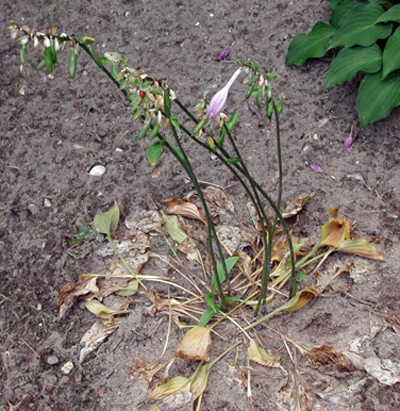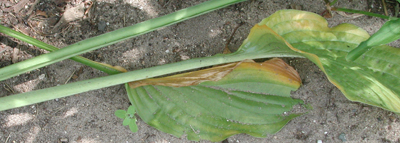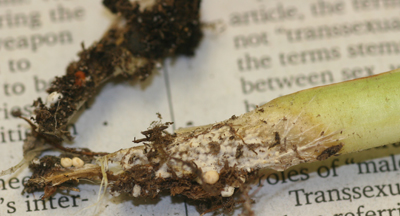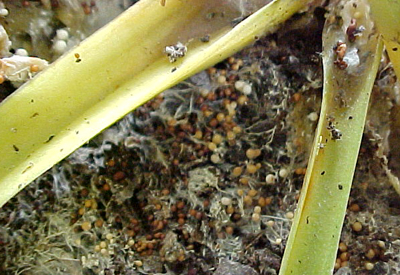Sclerotium or southern blight
July 8, 2015
Root and stem rots
Pathogen
Sclerotium rolfsii.

Collapse of lower leaves.
Hosts include
Ajuga, Anemone, Aquilegia, Campanula, Coreopsis, Delphinium, Dianthus, Digitalis, Helianthus, Hosta, Lathyrus, Liatris, Lilium, Limonium, Lupinus, Monarda, Penstemon, Phlox, Rudbeckia, Salvia, Scabiosa, Sedum and Veronica.

Typical chlorosis caused by Sclero-tium rolfsii infection on Hosta. Chlorosis develops as the petioles are degraded by the fungal pathogen.
Symptoms
Wilting, water-soaked lesions on succulent stems and petioles, crown rot, plant collapse and death. Fluffy fungal mats may be present on the soil surface or on affected plant tissues. Light brown sclerotia, about the size of mustard seeds, may also be present in clumps on the affected plant tissue.

Hyphae and sclerotia are visible on this rotted hosta petiole.
Spread
This is a soil-borne pathogen. Moving soil or diseased plant material spreads the disease. The pathogen can persist for an extended time in soil as sclerotia. During hot, humid conditions, sclerotia germinate, producing fungal mats that can infect susceptible hosts. Sclerotium rolfsii rarely produces spores, so dispersal by air movement is not significant.

Sclerotia look like mustard seeds on the soil surface surrounding the crown of a rotted plant.
Management
Good sanitation and pathogen exclusion are important steps in limiting disease. Carefully inspect incoming plant material for signs of disease. Remove and destroy affected plants, and avoid spreading soil from infected areas. Mulch used around field-grown plants or plants in the landscape may favor growth of S. rolfsii. Limit use of mulch in sites with a history of S. rolfsii. Fungicide applications (drenches or incorporated granular materials) can be used preventively to control crown rot.
Resource for additional information
Crown Rot, A Serious Disease of Hosta and Other Ornamentals, an Iowa State University Extension publication, February 2000.
Print a PDF of this page: Sclerotium or southern blight



 Print
Print Email
Email
